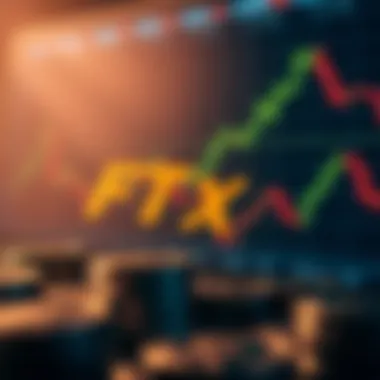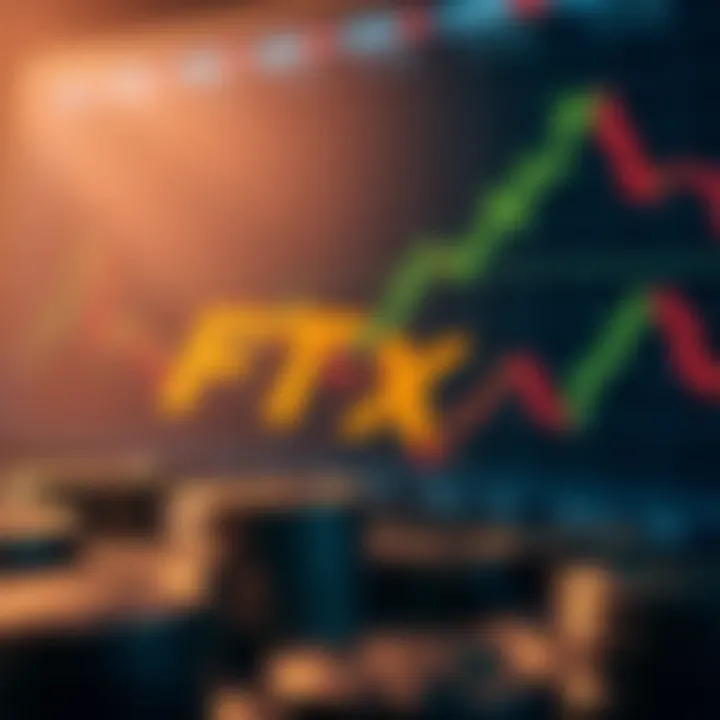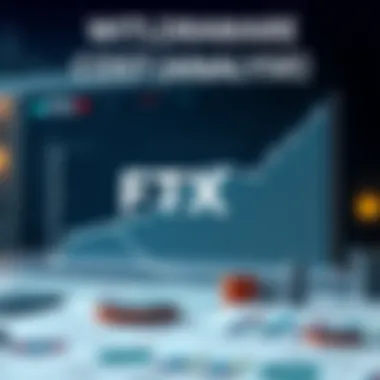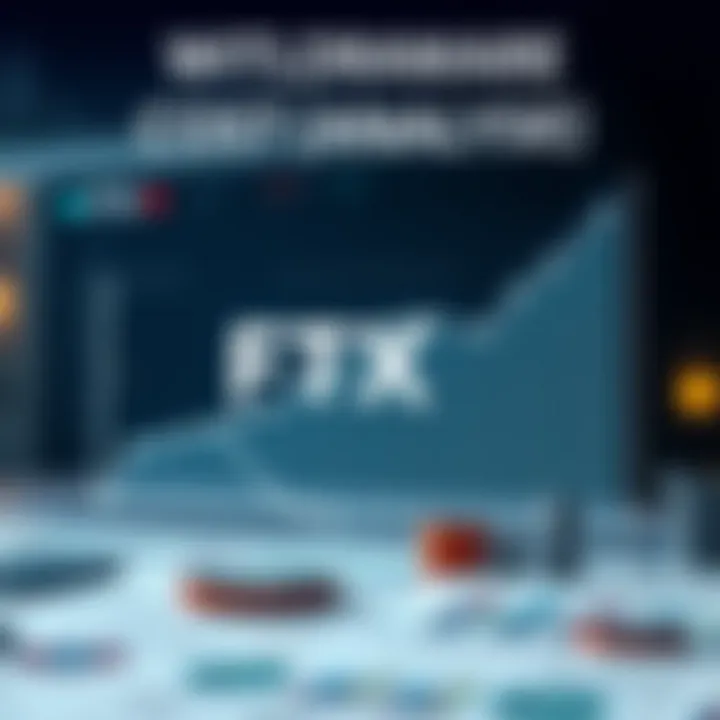Analyzing Costs on the FTX Platform: Essential Insights


Intro
In the ever-evolving landscape of cryptocurrency, understanding the financial implications of various trading platforms is crucial. As traders gear up to utilize the FTX platform, they should be aware not just of the potential gains, but also the costs that can quietly chip away at profits. This article seeks to break down the components of FTX costs in a way that allows investors to make well-informed decisions.
By analyzing trading fees, withdrawal costs, and leverage effects, we aim to equip users with the knowledge they need to navigate the complexities of trading in digital currencies. It’s essential to delve into these aspects, as the cryptocurrency world is rife with hidden fees and unexpected charges that can turn a promising trade into a less lucrative venture.
Understanding Cryptocurrency Concepts
To grasp the cost structure of any cryptocurrency platform, it’s vital to have a solid understanding of some foundational concepts. Let's explore how blockchain technology underpins these transactions, along with essential terminology every investor should familiarize themselves with.
Blockchain Technology Explained
At its core, blockchain is a decentralized ledger that records all transactions across a network. Each transaction is grouped into blocks, which are linked together in a chronological order to create a chain. This system boosts transparency and security, eliminating the need for intermediaries such as banks.
Key Terms Every Investor Should Know
When delving into the world of cryptocurrency trading, familiarizing yourself with certain terms is imperative. Here are some essential terms:
- Altcoin: Any cryptocurrency other than Bitcoin. The term derives from "alternative coin."
- ICO: Initial Coin Offering, a fundraising mechanism in the crypto space.
- Wallet: A digital storage for your cryptocurrencies, which can be software-based or hardware-based.
- Market Cap: The total value of a cryptocurrency, calculated by multiplying its price by the total number of coins in circulation.
- Liquidity: Refers to how easily an asset can be converted into cash without affecting its market price.
These definitions act as a launching pad into the more complicated aspects of trading on platforms like FTX. Knowing this terminology can help prevent misunderstandings and enhance the trading experience.
Market Analysis and Trends
Shifting focus to price trends and market dynamics, understanding the current landscape is pivotal for both seasoned and new investors. Various factors influence cryptocurrency markets, and keeping an ear to the ground can mean the difference between profit and loss.
Current Market Trends in Cryptocurrency
As of late 2023, cryptocurrency markets have witnessed some notable trends.
- Increased Institutional Investment: Large financial players are entering the crypto space, lending credibility and stability.
- Regulatory Scrutiny: Governments across the globe are looking into effectively regulating cryptocurrencies, which may influence market dynamics.
- DeFi Boom: Decentralized Finance has gained traction, providing alternatives to traditional financial services.
Investment Strategies for Different Market Conditions
Regardless of the market trends, certain strategies can help navigate the waters:
- HODLing: Buy and hold strategy; ideal during bullish markets.
- Day Trading: Quick trades based on daily market movements, suitable for volatile markets.
- Diversification: Spreading investments across various cryptocurrencies to mitigate risk.
- Technical Analysis: Utilizing charts and other tools to identify potential trading opportunities.
"In the crypto world, knowledge is not just power; it’s survival."
Understanding these investment tactics in relation to FTX costs will provide a clearer picture of how to optimize your trading experience. With this foundation laid, we can dive deeper into the specifics of fees, withdrawals, and leverage in subsequent sections.
Intro to FTX Costs
When it comes to engaging with the FTX platform, understanding the associated costs should be at the forefront of any investor's, trader's, or analyst's mind. The world of cryptocurrency trading is turbulent, and the costs tied to transactions, withdrawals, and other operational elements can significantly impact one's profitability.
The FTX exchange has made a name for itself due to its robust features and diverse offerings. However, these benefits often come with costs that can surprise the unprepared user. Therefore, having a firm grasp of what these costs entail, how they function, and the potential hidden fees is crucial for anyone looking to navigate this terrain successfully.
By dissecting FTX's fees, one can make more informed trading choices. This insight isn't just about avoiding pitfalls; it's about leveraging the platform to optimize returns on investment. Analyzing the components of FTX costs means taking a hard look at trading fees, leverage implications, and withdrawal conditions, among others. Understanding these financial aspects empowers users to gauge the overall investment strategy better and adjust accordingly, ensuring that there are no unexpected losses eating away at hard-earned profits.
The Significance of Understanding Costs
Knowing the costs associated with trading on FTX is an integral aspect of one’s trading strategy. While some may think that trading is merely about selecting cryptocurrencies, the reality is far more intricate. Each trade comes with fees that can shift the balance from profit to loss quite easily. Hence, having a clear perspective on these costs helps in making tactical decisions rather than emotional ones.
"The willingness to look beyond the surface enables traders to surf on the waves of the market, rather than drown in the tide of hidden costs."
Moreover, the trading landscape can be highly competitive. Users who take the time to understand costs have a strategic advantage. For example, being aware of the fee structures and how they change based on trading volume can lead to savings and potentially larger profits. Without this knowledge, a trader might find themselves at a disadvantage, swallowed up by fees that they did not anticipate.
FTX Platform Overview
FTX has emerged as a prominent player in the cryptocurrency industry, known for its innovative products and user-friendly interface. Initially launched in 2019, the platform quickly gained traction among both retail and institutional investors. It offers more than just standard trading; users can trade futures, options, and leverage tokens, among other assets. This rich offering can attract diverse users from different backgrounds—each with unique trading strategies.
Yet, with this diversity comes complexity, especially regarding fees. Navigating the ins and outs of FTX can be daunting without proper insight into how its fee structures operate. The exchange is designed to cater to serious traders who appreciate nuanced features; however, this same depth requires careful consideration of costs. For example, leverage can amplify both gains and losses, thus magnifying the importance of understanding potential fees in situations where leverage is employed.
Ultimately, having a firm grasp of the various costs associated with using FTX can lead to wiser decision-making in a fast-moving market. The combination of sophisticated trading options and varying costs makes it imperative for users of all levels to familiarize themselves with both the tools available and the costs incurred.
Understanding Trading Fees
Trading fees are the lifeblood of platforms like FTX. In this section, we will peel back the layers on trading fees, focusing on how these costs intertwine with users' strategies and the overall profitability of their trading activities. Being aware of these fees is akin to reading the fine print; it can spell the difference between a flourishing trading career and one that flounders.
Understanding trading fees is not merely a matter of calculating costs; it's about grasping the broader implications on one's investment strategy. Traders, big and small, whether they are managing large portfolios or dabbling with smaller investments, must account for these fees in their calculations. To navigate the complex world of crypto trading effectively, one must integrate fee considerations into their decision-making process.
The key elements to consider include:


- The different types of trading fees, each with unique impacts on various trading methods.
- How trading fees affect overall profitability, especially in a world where margins can be razor-thin.
With the rising competition among crypto exchanges, understanding the structures of these fees can often reveal hidden opportunities. It influences traders' choice of trading pairs, strategies, and ultimately their success in the market. Let's dive deeper into these critical components, beginning with a detailed explanation of spot trading fees.
Spot Trading Fees Explained
Spot trading fees are the charges taken by FTX every time a trader buys or sells a cryptocurrency at the current market price. These fees vary based on whether one is a maker or a taker in the trade. The distinction is important:
- Maker: When you place an order which isn't filled immediately, you are a maker. For instance, if you place a limit order that adds liquidity to the order book, you are classified as a maker.
- Taker: Conversely, if you buy or sell immediately to fulfill a standing order, you are a taker. This type of transaction typically incurs higher fees since it decreases the liquidity for others.
The spot trading fees on FTX can fluctuate based on the trading volume. Higher volumes can lead to decreased fees, thereby incentivizing active trading.
For example, a typical fee for a taker could hover around 0.07%, while a maker might enjoy a fee as low as 0.02%—a significant difference, particularly for frequent traders.
It's essential to monitor your trading style, as being aware of whether you are a maker or taker can save significant amounts in fees over time.
Futures Trading Fees
Futures trading comes with its own set of fees, separate from standard spot trading. On FTX, futures contracts allow traders to speculate on the price movements of various cryptocurrencies without actually holding the underlying assets.
The fees relate primarily to:
- Trading fees: Similar to spot trading, futures fees are determined by whether you are a maker or a taker. Generally, futures trading fees are lower than spot trading fees, but the difference isn’t substantial. This model incentivizes liquidity in futures as well.
- Funding fees: In futures trading, funding fees become relevant for positions held overnight. Every few hours, either the long or short position must pay the other based on current interest rates determined by the market. This can add up quickly, making it crucial for traders to factor these fees into their cost analysis.
Fee Tiers and Volume Discounts
FTX also implements a tiered fee structure, which has been designed in a way to reward high-volume traders. Here’s how it works:
- Volume brackets: As a trader’s 30-day trading volume increases, they might qualify for lower fee tiers, decreasing their overall costs significantly.
- Levels: FTX's fee model might go from a level one for average traders to level six for those with the highest volumes. As you move up these tiers, both your taker and maker fees decrease.
Furthermore, taking advantage of volume discounts can result in substantial savings. A trader who engages in significant transactions can pay far less on a per-trade basis than a casual trader, making it crucial for high-frequency traders to understand and leverage these fee structures.
Withdrawal Costs and Conditions
When navigating the FTX platform, understanding withdrawal costs and conditions is crucial. These costs can significantly affect an investor's net profits, especially for those who actively trade or move funds frequently. Knowledge of withdrawal specifics ensures that users make informed decisions, preventing unpleasant surprises that could erode their potential earnings.
Moreover, with the increasing complexity of cryptocurrency trading, withdrawal conditions can vary greatly, influenced by factors such as asset type, network protocols, and even external market conditions. Thus, grasping this aspect empowers traders to optimize their strategies, balancing entreé and exit costs effectively.
Types of Withdrawals
Withdrawal types on FTX generally come in two flavors: crypto withdrawals and fiat withdrawals.
- Crypto Withdrawals: The most common form, allowing users to move their funds to personal wallets or other exchanges. This can include various cryptocurrencies such as Bitcoin, Ethereum, and many altcoins. Each crypto asset may have distinct protocols and rules that impact the withdrawal process.
- Fiat Withdrawals: Users can convert their crypto holdings back into traditional currencies like USD or EUR, which can be deposited directly into bank accounts. This option often introduces a layer of complexity due to additional fees or processing times associated with banking institutions.
Understanding these withdrawal types allows traders to manage their funds more efficiently, particularly in anticipation of market movements or liquidity needs.
Typical Withdrawal Fees
Withdrawal fees on FTX can vary, influenced largely by the asset being withdrawn. For example, withdrawing Bitcoin might incur a different fee than withdrawing USDT. Typically, the fees are set in the crypto itself, meaning they can fluctuate according to market conditions.
- Bitcoin withdrawal fees could hover around 0.0005 BTC, depending on network congestion.
- Ethereum fees might be similar or vary with the gas fees on the network.
These fees can sometimes feel like a small price to pay for the convenience, yet they add up, especially when making frequent withdrawals. Thus, traders should budget for these to avoid unexpected dips in their overall returns.
Additionally, many users might find themselves blissfully unaware of the specific withdrawal fees until they attempt to execute a transfer, emphasizing the importance of preemptive research. As such, verifying fees in the FTX interface can initially stave off confusion down the line.
Minimum Withdrawal Limits
Most exchanges, including FTX, impose minimum withdrawal limits which vary based on the asset type. This means that users might be unable to withdraw small amounts because they won't meet the required thresholds. Here’s an example of the typical limits one might encounter:
- Withdrawal Minimum for Bitcoin: 0.001 BTC
- Withdrawal Minimum for Ethereum: 0.01 ETH
Being cognizant of these limits is vital for traders and investors alike—especially those engaged in micro-trading or trying to capitalize on small market movements. Failing to meet the minimum can tie up funds and may prompt frustration, emphasizing the importance of strategic planning when managing withdrawals.
Each of these aspects—types, fees, and limits—interact in ways that can greatly influence a trader’s strategy. Therefore, a clear grasp of withdrawal costs and conditions is not merely a good practice but a vital part of successful trading on the FTX platform.
Fees for Advanced Trading Features
In the realm of cryptocurrency trading, please don’t underestimate the importance of understanding advanced trading features, as they can dramatically alter your trading dynamics. While basic trading fees might be somewhat manageable, advanced features like leveraged tokens and over-the-counter (OTC) trading can come with their own unique cost structures that aren’t always clearly outlined. These fees can significantly influence your trading outcomes, so getting the lowdown on them is crucial.
Leveraged Tokens
Leveraged tokens present a unique avenue for traders, allowing them to gain exposure to a larger position without needing to fund the total amount. In layman's terms, if you think a cryptocurrency’s price is headed north, using a leveraged token can amplify your profit potential, but at a cost.


One needs to approach leveraged tokens with caution. Yes, they can provide impressive returns, yet the fees tied to their trading can vary significantly depending on your trading volume and market conditions. For instance, the higher your leverage, the more you could be on the hook to pay in fees. Some traders may feel these fees are somewhat hidden, appearing smaller than they really are until the bills start piling up.
"Leveraged trading sounds like hitting the jackpot but keep your eyes peeled; those fees can sneak up like a cat on a mouse!"
It’s essential to factor in these costs when devising your overall trading strategy. If you’re tossing around the idea of trading leveraged tokens, make sure to study how each token operates, the associated fees, and the potential risks involved.
FTX OTC Trading Fees
Next up, we have OTC trading on FTX, which is another ballgame altogether. Ideal for traders dealing in large volumes, OTC trading can help bypass some of the market's limitations, providing a better price without causing volatility in the market. However, this convenience comes with its own fee structure.
The fees for OTC trading are often not publicly displayed and depend heavily on the negotiated terms between you and the broker. They can fluctuate based on market conditions and your trading habits. Traders should consider leveraging the negotiation aspect to optimize their costs effectively.
Understanding the nuances of OTC fees is vital. Here’s a few points to keep in mind:
- Volume: The more you trade, the better your chances for a favorable fee.
- Negotiation: Don’t hesitate to discuss terms; in many cases, you can strike a better deal.
- Market Factors: Be mindful that during times of high volatility, fees can spike unexpectedly.
In sum, while advanced trading features on FTX offer significant advantages, they are not without their costs. Awareness and thorough examination of each fee structure can greatly fortify your trading strategy and enhance your profitability.
Currency Conversion Costs
Currency conversion costs are a vital factor that often gets brushed under the rug when trading on platforms like FTX. It’s not just about the flashy gains you see on your trading dashboard; understanding how currency conversions work can significantly impact your trading actions and potential returns. When investing in cryptocurrencies, you often find yourself dealing with multiple currencies, each with its own quirks and cost implications.
Understanding Conversion Fees
Conversion fees can sneak up on traders unaware. When you are trading various cryptocurrencies, you might have to convert one asset to another. FTX charges a fee for these conversions, which can vary based on the currencies involved. If you think about it, every time you make a conversion, it's like paying a toll on a toll road. You may cross the bridge without noticing the small costs along the way, but those little fees can accumulate quickly.
- Key aspects of conversion fees include:
- Percentage-based Fees: These typically depend on the amount you're converting. Larger conversions may come with a higher fee percentage.
- Flat Fees: Some conversions could have flat fees regardless of the amount being converted.
- Inherent Exchange Rate Markups: Additional charges could arise from unfavorable exchange rates that the platform may impose compared to market rates.
Ultimately, if you are not mindful of these conversion fees, you might find your profits dented without even realizing it. Keeping an eye on these costs could save you a bunch in the long haul.
Market vs. Fixed Rates
When dealing with currency conversions, you may come across two main types of rates: market rates and fixed rates. Choosing between these options could mean the difference between a profitable trade and a costly error. Understanding which applies to your situation is crucial.
- Market Rates
- Fixed Rates
- Market rates fluctuate based on supply and demand, meaning you might get a better or worse rate depending on the moment you make the conversion. For instance, if you convert during a peak trading time when activity is high, you might hit a favorable exchange rate.
- Fixed rates are set and do not change. They can offer stability, so traders know exactly what they will pay upfront. However, in certain market conditions, fixed rates could be higher than the prevailing market rates. This means there’s a chance you might miss out on savings if market rates drop just after you convert.
Consider this: it's like walking into a store and seeing a pair of shoes marked at $100 (fixed rate) when a nearby shop has them for $80 (market rate). If you jump in without checking the second shop, you may end up overpaying without even realizing it.
In summary, currency conversion costs are a subtle yet influential factor in your FTX trading strategy. Paying attention to conversion fees and understanding the nuance between market and fixed rates can empower you to navigate the tricky waters of cryptocurrency trading more effectively and enhance your overall profitability.
Comparative Analysis of Fees
A thorough Comparative Analysis of Fees is essential for anyone keen on maximizing their investment potential in cryptocurrency trading. By examining fees charged by FTX and contrasting them with those of other exchanges, an investor can uncover the nuances that significantly influence trading outcomes. One key consideration is that trading costs can vary dramatically from one platform to another, and this can directly shape choices regarding where to execute trades.
FTX vs. Other Exchanges
When we compare FTX with other significant players like Binance or Coinbase, it's not just about the base fees, but also the structure and hidden costs that come into play. FTX's fee model is lauded for being relatively straightforward, but that doesn’t mean other exchanges don’t offer competitive alternatives or even perks. For instance:
- Binance: Often perceived as a titan within crypto, its tiered fee structure is designed to reward high-volume traders. Newcomers may find themselves paying fees that stack up quite quickly, especially if they aren't aware of the discounts for holding BNB, the native token.
- Coinbase: While it's user-friendly for novices, the fees can be steep for smaller transactions. Ignorance of the layout might lead users to pay more than they bargained for when converting and transferring coins.
- Kraken: Takes a different route by emphasizing lower fees in exchange for adjusting to a complex fee structure. Traders must actively track their trading volume to fully benefit.
Through this comparative lens, one finds that the best option heavily depends on trading habits, as specific exchanges may favor particular user profiles over others. Consequently, evaluating fees across platforms is not just a matter of selecting the cheapest option but rather identifying the most aligned with one’s trading style and volume.
Evaluating Overall Value
While costs are an important factor, they're just one piece of the puzzle. Here, the term "overall value" takes on great significance and encompasses various elements. Value isn’t only about the monetary expenditure laid out in trading fees, but also it stretches into aspects like security measures, user experience, customer service, and available coins.
- User Experience: Some exchanges, might charge a bit more, but they offer a seamless interface and invaluable tools, making trading smoother for the user.
- Security Protocols: Users must also consider the safety of their funds. A platform with higher fees could reflect better security practices, which could save traders from potential catastrophic losses.
- Available Trading Features: Exploring advanced tools, like margin trading or staking options, should be counted among value propositions. A platform that offers more features for traders may justify higher costs.
Considering these diverse factors ensures that the final decision transcends mere numerical comparisons—creating a well-rounded, insightful assessment of which platform truly offers the best value.
"In the end, the choice of platform should be more about fitting one's trading style and risk tolerance rather than just focusing on which one charges less."
By thoroughly investigating costs, structures, and the overall value provided by each exchange, traders can optimize their investments and improve their profitability effectively.
Impact of Costs on Trading Strategy
In the realm of cryptocurrency trading, costs play a pivotal role in shaping an investor's strategy. Understanding the implications of different fees is fundamental to making informed trading decisions. Whether you're a seasoned trader or just dipping your toes in the water, knowing how costs can impact returns directly influences your overall trading performance.


How Fees Affect Profit Margins
When it comes to trading, every cent counts. Fees, whether they stem from trading operations, withdrawals, or advanced features, act as a silent profit saboteur. For instance, if you engage in frequent trading on the FTX platform, the cumulative effect of trading fees might eat away at your potential profits. That $100 trade could potentially yield a profit of $10. But once fees come into play, that figure might dwindle down to $8 or even less, depending on how much you're charged.
Common types of fees include:
- Spot trading fees
- Futures fees
- Withdrawal fees
Because profit margins shrink as fees increase, it’s crucial to have a firm grip on the fee structure before diving into any transactions. Understanding how various trading types incur costs can be the difference between a profitable strategy and a losing one. To this end, some traders adopt strategies that minimize fees, such as limiting the frequency of trades or targeting larger-volume trades that benefit from tiered fee discounts.
"Every trader must recognize that in the pursuit of profit, costs can weigh heavily on the outcome of their efforts."
Long-Term Cost Considerations
In the fast-paced world of trading, it can be easy to overlook long-term considerations in favor of immediate gains. However, when evaluating FTX costs, a broader perspective is necessary. If you plan on utilizing the platform over an extended period, the cumulative costs can significantly impact your net returns.
Investors must evaluate not just immediate fees but also how those fees accumulate over time. Here are key factors to keep in mind:
- Frequency of Transactions: If you're trading multiple times a day or week, those fees can stack up quickly. An initial investment that grows might seem attractive, but when you factor in repeated fees, the actual growth may not be as rosy.
- Market Conditions: In times of volatility, the frequency of trades might increase as traders react to market movements. This is especially critical for those using leverage; even a small change in market dynamics can magnify the impact of fees on your overall strategy.
- Future Changes in Fees: Be aware that exchanges can modify their fee structures over time. Staying informed about upcoming changes could allow you to adjust your trading strategy accordingly, thereby reducing long-term costs.
Moreover, tax implications of your trades could further tie into this long-term picture. Depending on the jurisdiction, frequent trading might elevate your tax burden or impact how you're taxed on your gains.
By maintaining a watchful eye on both short-term and long-term costs, you can craft a trading approach that is not only focused but, more importantly, financially sound. This perspective requires diligence, research, and a flexible mindset to adapt strategies as needed.
Regulatory Considerations
Navigating the landscape of cryptocurrency exchanges, like FTX, requires a solid grasp of regulatory considerations. Regulations in this space are evolving rapidly and can differ significantly across jurisdictions. This section digs into why these regulations are vital, looking deep into compliance costs and their implications for users.
Understanding Compliance Costs
Compliance costs can fundamentally shape the way exchanges operate. For FTX, these costs stem from a myriad of requirements imposed by regulatory bodies, including customer verification processes, data security mandates, and ongoing reporting obligations. The term "compliance costs" encompasses not just hard costs such as fees for legal advice and technology platforms to ensure adherence, but also the less tangible costs of time and effort devoted by teams to maintain compliance.
- Importance of Compliance:
- Hidden Costs: Sometimes compliance requirements can introduce unexpected financial burdens. For instance, the need for advanced identity verification tools or extensive legal consultations can hit an exchange’s budget, indirectly affecting trading fees.
- Protects against potential fines and sanctions which can devastate not only the bottom line but also an exchange's reputation.
- Promotes trust and confidence among users, crucial in the cryptocurrency realm where skepticism often runs high.
Understanding these costs isn’t just for the platform; it’s equally vital for users to be informed about how compliance factors into the overall cost of trading. As regulations tighten, exchanges might pass some of those costs onto traders, influencing their trading strategies and profitability.
Implications for Users
The regulatory landscape directly impacts users both positively and negatively. On one hand, robust regulations can foster a safer trading environment, mitigating the risks that users face from fraud or market manipulation. On the other hand, the ramifications of compliance can lead to increased fees or limited access to services for users.
- Positive Implications:
- Possible Drawbacks:
- Increased Security: Regulatory frameworks are generally designed to protect users, meaning their investments might be safer under more stringent rules.
- Market Integrity: Regulations help maintain a level playing field, reducing the chances of market manipulation by bad actors.
- Higher Fees: As mentioned, compliance costs can trickle down to users. Traders may find themselves facing higher trading fees or withdrawal costs.
- Access Restrictions: Stricter regulations might limit the types of assets, trading options, or even the exchanges available to users in certain regions.
"Understanding the regulatory implications is key for effective trading strategy; it’s not just about costs, but about ensuring longevity in your trading practices."
In closing, navigating the maze of compliance is essential for anyone engaging with FTX or similar platforms. Awareness of these regulatory considerations allows users to make informed decisions, balancing potential costs with the benefits of increased security and market integrity. By considering how compliance costs influence both the platforms and users, traders can position themselves more effectively in the complex world of cryptocurrency.
Culmination: Navigating FTX Costs Effectively
Navigating the costs associated with the FTX platform is essential for anyone looking to maximize their trading experience. Understanding these costs can make a significant impact, transforming how traders approach their portfolios. One of the primary considerations is being aware of the various fees related to trading, withdrawals, and additional services. Each fee, while sometimes seemingly minor on its own, can accumulate and sap potential profits.
Traders should take a moment to review their trading strategies in light of these costs. The importance of meticulous planning and budgeting cannot be overstated. Many traders enter the market with a focus on maximizing returns but often overlook how fees can chip away at profits. Keeping a careful eye on the overall optimization of trades, including timing and transaction types, can provide significant advantages in the long run.
Effective cost management on FTX can lead to a notable improvement in trading performance.
Moreover, it's also crucial to stay informed about future changes in regulations and platform fees, as the cryptocurrency landscape continues to evolve. The regulatory environment can affect operational costs, and being aware of these changes can help provide a competitive edge.
Ultimately, mastering the costs associated with FTX is about more than just accountability; it's about strategic positioning in a fast-paced trading environment. By equipping themselves with the necessary knowledge, traders can navigate these waters more effectively, ensuring better outcomes.
Final Thoughts on Cost Management
In addition to recognizing fees, understanding how to manage costs effectively will come down to having a comprehensive view of one’s trading behavior. Each trader has their own unique patterns, and it is vital to align strategies accordingly. Here are several imperatives:
- Regularly analyze your trading history to gauge total cost impact.
- Use more efficient transaction types when available to minimize fees.
- Incorporate tools offered by FTX, like advanced order types, to assist in more effective trading strategies.
Being proactive can help in identifying areas of improvement. A trader can by all means benefit from predictive strategies concerning cost by focusing on optimizing trade techniques and minimizing unnecessary expenses.
Looking Ahead to Future Changes
The future of trading on platforms like FTX is likely to be shaped by both technological developments and evolving regulatory frameworks. Traders should remain vigilant and flexible, adapting to new tools and practices as they arise. Here are possible trends to keep an eye on:
- Introduction of new fee structures that could change profitability.
- Technological advancements that may simplify fee management, enhancing user experience.
- Changes in compliance requirements that may add or reduce costs.
By monitoring these aspects and understanding their implications thoroughly, traders can adjust their strategies effectively, maintaining a competitive edge while optimizing their cost management efforts. Being prepared for unforeseen changes and continuously fine-tuning cost strategies can empower a trader in this ever-evolving marketplace.
In summary, a deep dive into the costs associated with FTX can yield insights that support better decision-making in trading. With these considerations at the forefront, traders will be better positioned to make informed investments and effectively navigate the intricacies of the cryptocurrency market.















